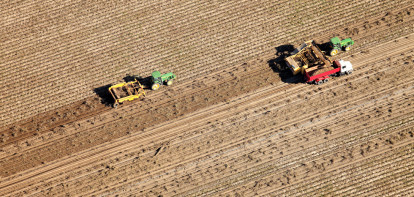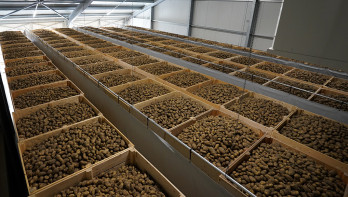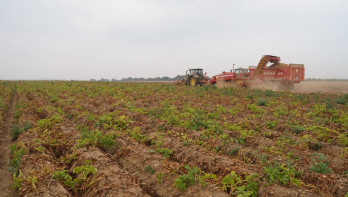Analysis Potatoes
How do potato crops progress compared to previous years?
The crop condition and tuber growth are widely divergent this season across the different potato fields of the Crop Tour. This discrepancy is often due to the differences in planting times, but the abundant water and poor soil structure have also left deep marks on the growing season. The typical Dutch summer ensures that the weather is conducive to growth. This is evident during field inspections. Some fields are in line with other years in terms of crop condition, as shown by comparisons among different Crop Tour fields.
In this comparison, the current crop condition of various Crop Tour fields with the Innovator variety is compared to other years. Some farms have participated for several years, allowing for a good comparison of crop conditions. Others have participated for a shorter period, so sometimes images from previous years of fields in the same region are used. This aims to provide as accurate and reliable a picture as possible of the crop condition of the Innovator variety compared to other growing seasons.
Huge Differences
The current season is characterized by the excessive rainfall, making it difficult to get a consistent picture of the crop condition and growth. There are areas where potato planting was completed in May, while elsewhere, particularly in the south, there was still a lot to be done by the end of June. Additionally, within the same region, the differences are enormous. The abundant water has caused flooded spots across the Netherlands, resulting in the loss of the first hectares. Despite some areas where the crop is also affected by the excessive rainfall, it is a fact that crop growth is far from stagnant with the typical potato weather of recent weeks.
In the images of the different fields, not always a single plant is shown, but in some cases, two or even three. The number of tubers shown can thus come from multiple plants.

Starting with the Crop Tour field in IJzendijke (Zeeland), where part of the field was replanted this year due to water damage. This has resulted in irregular growth within the field. The contrast with last year is significant, as after a late spring in May and June, it became extremely dry. The previous growing season started very slowly with an average late planting date and followed by poor weather, which should be kept in mind when drawing conclusions and seeing comparisons. The number of tubers was significantly lower on average in 2023 than this season, and the growth at the beginning was difficult for many fields due to the poor weather. Some growers had to irrigate three times (!) by July since planting last growing season.
Potato grower Salomé is participating in the Crop Tour for the second season, so there is no comparison with previous years. However, a comparison can be made with the field in Driebergen (Zeeland), where cultivation is under similar conditions and is located nearby. Irrigation is not used here either, just like in IJzendijke.

Further north, at the Crop Tour field in Hellevoetsluis (South Holland), there is a lag in tuber size compared to two previous seasons.

The Crop Tour field in Dronten (Flevoland) was planted at the end of March this season by potato grower Adriaan Wortman. As a result, the tubers are already well developed and, according to the grower, there are more than ten tubers per plant due to the ample moisture. In the image, even 26 tubers can be counted from two plants. The comparison includes other fields in the Dronten area, such as the field of Van Liere in Dronten in 2022 on July 7.

The Crop Tour field in Wouw, North Brabant, was planted on May 18 this season, somewhat later than most other Crop Tour fields. The image below shows that there is a lag in tuber size this season compared to 2023. It is still too early to speak about tons per hectare, as the growing season started later and much can still happen this season, especially with the typical potato weather now. However, last season's net yield from this field was 65.5 tons per hectare, giving an idea of the yield from potatoes of that size last year. That yield of 65.5 tons was the second highest yield. The average trial digging in 2023 resulted in 49.9 tons per hectare.

In 2022, the field in Fijnaart (North Brabant) last participated. It is located close to Wouw. Although the soil type is somewhat different, a comparison was made with 2022 between the fields of Wouw and Fijnaart due to their proximity.
In Elst, Gelderland, tuber formation is further developed compared to a season earlier. Potato grower Daan Tap also indicated that his crop is in better condition than last season.

From the past two growing seasons, there is no image around the current period of the tubers on the Crop Tour field in Eethen (North Brabant), but there is from 2021. Additionally, the Innovators from this field are significantly larger than last growing season, when replanting was done later due to considerable Fusarium infestation.

The current season and also the 2023 growing season are quite unique with the wet spring compared to previous years. As mentioned earlier in this article, the 2023 growing season also started wet, but was followed by poor weather, causing a significant delay in the growing season. This season, on average, shows similar conditions as seen from the images. Although the height of the crop cannot be fully assessed from the images, various growers indicate that the crop is generally smaller this season than in other years. The plants are smaller, and a field is sometimes hardly closed.
Often, growers compare the current growing season to the previous one, as in this case with 2023. Compared to that year, the growth lag is relatively minor. However, when looking at images in the Crop Tour archive from other years, it is evident that the potatoes were generally much more developed around July 10. In the following overview, an image has been selected per growing season showing the average tuber size of that year around July 10.

The fact remains that with a late start, the growing season also extends longer. With ample moisture and moderate temperatures, the weather is conducive to growth. Of course, there is also significant water damage, but what remains still has potential. The further course of July, and particularly August, will be crucial for the potato yield. With drought and tropical temperatures, the crop can quickly deteriorate, shortening the growing season, which results in a lower yield per hectare. On the other hand, with the current conditions, there is significant potential for growth. Finally, the potatoes must also be harvested (successfully), which did not happen everywhere last year either.




